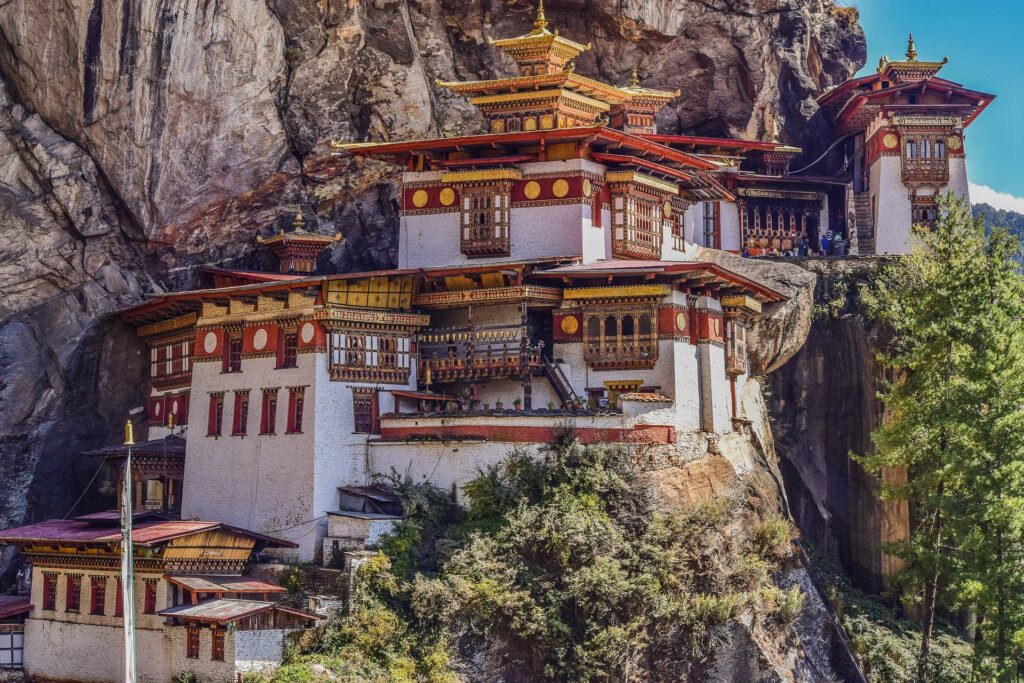Itinerary
On arrival at Paro Airport and after completing your Visa / Permit formalities you will be received by our Bhutan representative who will assist you in boarding your vehicle for transfer to Thimphu (2320Mts / 7656Fts, 65 Kms / 01½ to 02 Hrs), Thimphu is the capital town of Bhutan. Evening free at Leisure. Overnight at Hotel.
After breakfasts go for Thimphu sightseeing covering Memorial Chorten, Tashichho Dzong, Buddha Point (Kuensel Phodong), Changangkha Lhakhang (Monastery), Motithang Takin Preservation Centre, Drupthob Goemba / Zilukha Nunnery, Zangthopelri Lhakhang (Monastery). Overnight at Hotel.
After breakfasts visit National Library (Closed on Saturday, Sunday & National Holiday), Institute for Zorig Chusum (Traditional Art & Craft School) (Closed on Saturday, Sunday, National Holiday & During Summer & Winter Vacations), Textiles Museum (Handicrafts Shops) (Closed on Saturday, Sunday & National Holiday),. Later transfer to Gangtey (3000Mts/ 9845fts, 133 Kms / 6 Hrs One way). The drive is over Dochu La pass (3080Mts / 10102Fts) which is very scenic with a fascinating view of the mountains of Bhutan. A few kilometers beyond the Gangtey Monastery, on the valley floor lie, ’s the village of Phobjikha. This place is the winter home of black-necked cranes that migrate from the arid plains in the north to pass winter in a milder and lower climate. Overnight at Hotel in Gangtey.
After breakfast proceeds to Wangdi Enroute visit Phobjikha Valley (3000Mts / 9845fts, 85Kms / 3 to 3½ Hrs One way) The valley of Gangtey is one of the most beautiful. Black Necked Crane Information Centre, Gangtey Goempa (Monastery). Drive towards Wangdi. Check in to the hotel. Overnight at Hotel.
After breakfast visit Punakha Dzong, If time permits visit the Suspension Bridge and then proceed to Chimi Lhakhang (Monastery). Drive towards Wangdi. Check in to the hotel. Overnight at Hotel.
After breakfast transfer to Paro (2134Mts / 7000Fts, 135 km / 05 Hrs). En-route stop at Lamperi to visit Royal Botanical Garden. On arrival Paro, check in to the hotel. Afternoon free at leisure. Overnight at Hotel.
After breakfast go for Paro Sightseeing Drukgyel Dzong (Presently closed for tourists), Ta Dzong (National Museum-Closed on Saturday, Sunday & National Holiday), Rinpung Dzong, Kyichu Lhakhang (Monastery), Back to the hotel. Overnight at Hotel.
OR
PARO – FULL DAY HIKE TO TAKTSANG LHAKHANG (TIGER`S NEST)
Start the day early for a day hike to Taktsang Lhakhang (Tiger’s Nest Monastery) – The hike which is all the way uphill takes about 2 /3 hours one way through pine forests. Afternoon at leisure for go for shopping in the market. Overnight at Hotel.
Start the day early for a full day excursion to Haa via Chele-la pass (3800Mts / 12465Fts, 65 Kms / 02 to 03Hrs – One way) with packed or early breakfast. Visit Haa Dzong, Lhakhang Karpo, Lhakhang Nagpo, Wangchulo Dzong. Depending on the weather, road conditions, and time Haa excursion could be either taken from Chele-la Pass or from the Chozum side one can also opt for going from Chele-la Pass and returning from the Chuzom side or vice versa. Evening you drive back to Paro. Overnight at the hotel.
After breakfast transfer to Paro Airport for taking onwards connection.

